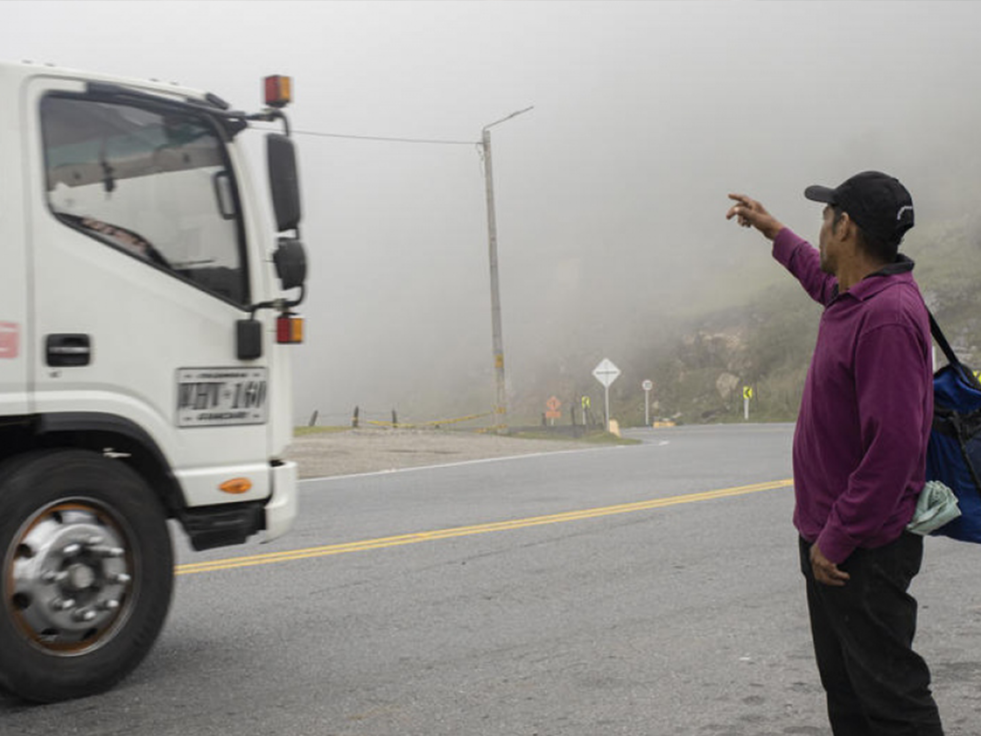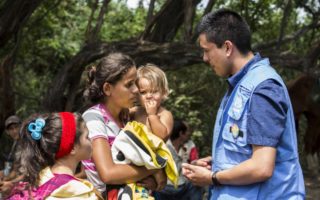
Alexander Pérez, 41, reaches the Berlin peak in Colombia after walking for several days from the Venezuela border, 135 kilometres away. © UNHCR/Hélène Caux
Weakened by hunger, hundreds of Venezuelan refugees and migrants cross the high Andes each day in search of safety in Colombia and beyond.
By Jenny Barchfield, in Berlín, Colombia
With his long sleeve shirt, cosy sweatpants and knockoff Crocs worn over hole-riddled socks, Víctor Sivira was better prepared than many of his compatriots for the frigid temperatures in Berlín, the highest, coldest, and most treacherous point in the daunting journey to find safety.
Untold numbers of Venezuelan refugees and migrants traverse the pass as they trek hundreds of kilometres across Colombia, climbing from near sea level to an altitude of over 3,000 metres.
Víctor and his friend and travel companion, Alexander Pérez, had set out from their homes in Venezuela’s north-western Lara state some four days earlier, crossing into Colombia over the Simón Bolívar International Bridge, which has become a symbol of the Venezuelan exodus.
More than four million Venezuelans have fled the political and social upheaval in their home country that has sparked crippling inflation, scarcities of basic foods and medicines, recurring blackouts, and widespread violence. Like so many other Venezuelan refugees and migrants seeking safety, Victor and Alexander’s overland journey took them through the so-called Knot of Santurbán, a daunting mountain range in the far eastern reaches of the Andes.
“I’ve never been through anything so difficult. It’s dangerous and freezing and exhausting.”
“I’ve never been through anything so difficult. It’s dangerous and freezing and exhausting. My entire body hurts,” said Víctor, a 33-year-old farm worker, who defied a pronounced limp – the result of a botched surgery following a motorcycle accident that left one leg four centimetres shorter than the other – to walk the 135 kilometres from the steamy border to fog-shrouded Berlín. “But it’s not like we had a choice. We had to leave. We were starving.”
It is not clear how many Venezuelans have made the journey, but data from shelters along the route suggests that some 100-250 people are setting out every day for destinations that include the Colombian cities of Cali and Medellín – both hundreds of kilometres away – as well as neighbouring Ecuador, Peru, or even Chile, South America’s southernmost nation.
On and on they walk, in hopes of meeting up with friends or relatives already established abroad; of securing jobs that will allow them to send remittances home to those they left behind; of finding safety, stability, and freedom.
Clusters of men, women, and children trudge along the narrow, winding highway that leads up and over the mountain pass. They walk in single file, hugging the shoulder to keep out of the path of the lorries and buses that come barrelling around blind curves. They often try to hitch a ride on passing trucks, but because the Colombian police fine those they catch carrying Venezuelans, drivers tend to be reluctant to give them lifts.
Some of the so-called caminantes, or walkers, as they are typically referred to in Spanish, shoulder backpacks; others drag unwieldly suitcases or cradle nursing infants or exhausted toddlers against their chests. They wear shorts and T-shirts and old tennis shoes or flipflops, the soles worn paper thin and often riddled with holes. Some wear no shoes at all.
Along the way, they eat and sleep in the soup kitchens and shelters – run by charities, humanitarian organizations, and even individuals – that dot the highway. And when there’s no room left in the shelters, they sleep along the side of the road, under the elements. The higher they climb, the colder it gets. They drape themselves with whatever they have – sheets, towels, socks repurposed as mittens – to stave off the frigid winds and temperatures that can drop to freezing.
Some have fallen victim to the journey. A 19-year-old woman was killed recently when a truck plowed into her outside a shelter. Others, their immune systems already compromised by food scarcities back in Venezuela, fall ill along the way.
A recent survey by UNHCR, the United Nations Refugee Agency, shows that more than half the nearly 8,000 Venezuelans interviewed face acute, specific risks during their journeys – with age, gender, health or other needs rendering them particularly vulnerable and in urgent need of protection and support.
Grexys González was hospitalized with amoebic dysentery on day three of her trek, outside a town called Pamplona. An accountant from a suburb of the northern Venezuelan city of El Tigre, 29-year-old Grexys saw no choice but to leave her job at a petroleum services company to undertake the overland journey after her company stopped paying its employees and she was no longer able to afford monthly doctors’ visits for her hypoglycaemic three-year-old daughter.
“I knew it was extremely risky, but I knew that if I didn’t take the risk, everything would just get worse,” she said, her voice raised over the din of the around five dozen other women, children, and babies packed into the shelter where she was spending the night after her release from the hospital.
“I knew it was extremely risky, but I knew that if I didn’t take the risk, everything would just get worse.”
Grexys, who weighed 63 kilos before the crisis in Venezuela, was down to just 47 kilos following the food shortages back home and her crippling bout of dysentery, her limbs spindly and her face gaunt, with purple hollows beneath her eyes. It was clear she was in no condition to continue the journey, but with no money and nowhere to stay for more than a couple of nights, she was in a tough spot.
“In Venezuela, we have a saying, ‘What comes easy goes away just as easily,’” said Grexys. “Obviously, none of this is easy. What we’re living through is extremely hard. But I think that if we can just get through this, better things will lie around the bend.”
To help vulnerable refugees and migrants from Venezuela, UNHCR has stepped up its response and is working closely with host governments and partners to support a coordinated and comprehensive approach. This includes supporting States to improve reception conditions at border points where the caminantes arrive in very precarious conditions, coordinate the provision of information and assistance to meet Venezuelans’ immediate basic needs including shelter.
Originally published by UNHCR on 05 September 2019





